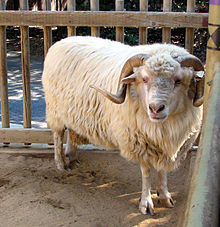 A Navajo-Churro ram | |
| Conservation status | DAD-IS: at risk[1] |
|---|---|
| Other names | American Four-Horned Sheep, Navajo Four-Horned Sheep |
| Country of origin | United States |
| Use | wool, milk, pelts, meat |
| Traits | |
| Weight | |
| |
The Navajo-Churro, or Churro for short,[3] (also American or Navajo Four-Horned) is a breed of domestic sheep originating with the Spanish Churra sheep obtained by the Diné around the 16th century during the Spanish Conquest.[4] Its wool consists of a protective topcoat and soft undercoat. Some rams have four fully developed horns, a trait shared with few other breeds in the world.[5] The breed is highly resistant to disease.[4] Ewes often birth twins, and they have good mothering instincts.[5] This breed is raised primarily for wool, although some also eat their meat.[6]
The common Diné word for the breed, Dibé dits’ozí, means "long fleeced sheep." T’áá Dibé is also occasionally used, meaning "first sheep."[5] The churro is important to Diné subsistence and culture.[7][8]
- ^ Breed data sheet: Churra / Spain (Sheep). Domestic Animal Diversity Information System of the Food and Agriculture Organization of the United Nations. Accessed August 2023.
- ^ a b Cite error: The named reference
stwas invoked but never defined (see the help page). - ^ "Navajo-Churro". Breeds of Livestock. Oklahoma State University Dept. of Animal Science. Archived from the original on 2009-01-23. Retrieved 2009-04-03.
- ^ a b "Navajo-Churro Sheep". Breeds of Livestock. Oklahoma State University Department of Food and Animal Sciences.
- ^ a b c Cite error: The named reference
conservancywas invoked but never defined (see the help page). - ^ "Navajo-Churro/United States of America". Breed Data Sheet. Domestic Animal Diversity Information System. Retrieved 2009-09-04.
- ^ Cite error: The named reference
Gasswas invoked but never defined (see the help page). - ^ Begay, Raphael (2023). "Sheep Is Life". El Palacio.
